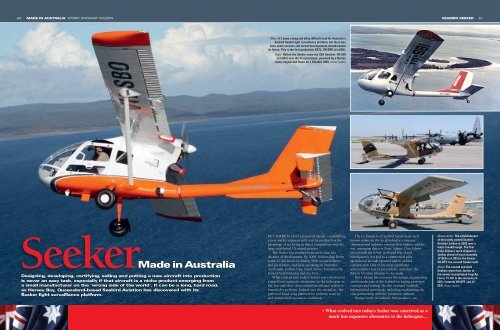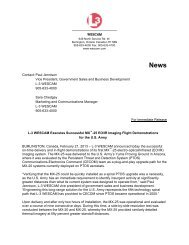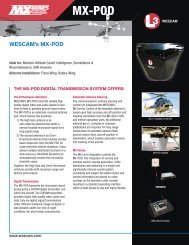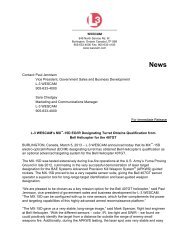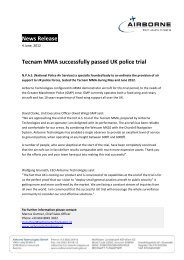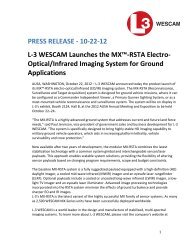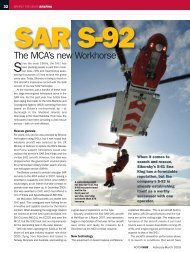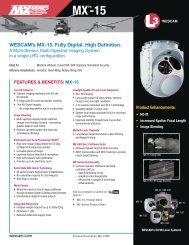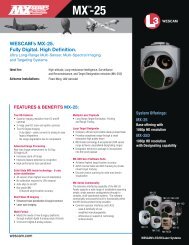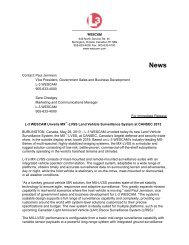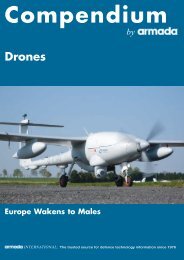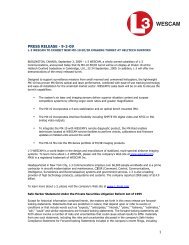You also want an ePaper? Increase the reach of your titles
YUMPU automatically turns print PDFs into web optimized ePapers that Google loves.
60 MADE IN AUSTRALIA STORY: STEWART WILSONSEABIRD SEEKER 61Main: It’s been a long and often difficult road for Australia’sSeabird <strong>Seeker</strong> light surveillance platform, but there hasbeen some success and recent developments should ensureits future. This is the first production SB7L, VH-SBO (c/n 006).Right: Before the <strong>Seeker</strong> came the SB5 Sentinel. VH-SBI(c/n 001) was the first prototype, powered by a Nortonrotary engine and flown on 1 October 1989. Photos: Seabird<strong>Seeker</strong>Made inDesigning, developing, certifying, selling and putting a new aircraft into productionis never an easy task, especially if that aircraft is a niche product emerging froma small manufacturer on the ‘wrong side of the world’. It can be a long, hard road,as Hervey Bay, Queensland-based Seabird Aviation has discovered with its<strong>Seeker</strong> light surveillance platform.AustraliaBUT THERE IS ALSO a potential upside – establishinga new market segment with a niche product has theadvantage of not being in direct competition with thelarge established US manufacturers.The <strong>Seeker</strong> has resulted from more than twodecades of development. By 2009, <strong>Seeker</strong>s had flownsome 11,000 hours including 5000 on surveillanceand patrol duty, and were operating in Australia,Azerbaijan, Jordan, Iraq, South Africa, Tanzania, theUnited Arab Emirates and the USA.What evolved into today’s <strong>Seeker</strong> was conceived asa much less expensive alternative to the helicopter inthe ‘low and slow’ observation/surveillance roles it isintended to perform. Seabird sees the aircraft as “thepreferred fixed wing platform for military, securityand commercial customers worldwide.”The co-founders of Seabird Aviation are wellknownnames in the local industry: companychairman and industry veteran Don Adams; and hisson, managing director Peter Adams. Don Adamsserved with the RAAF in World War II andsubsequently worked as a commercial pilot,agricultural aircraft operator and in airfieldconstruction. One of his most significantachievements was to successfully introduce theBritten Norman Islander to Australia.Peter Adams has overseen the design, engineeringand manufacture of the Seabird including prototypeconcepts and testing. He also oversees Seabird’sinternational operations, including establishing thevital partnership with the Jordanian industry.Design work on Seabird’s first product – an >>>Above centre: The establishmentof the jointly owned SeabirdAviation Jordan in 2003 was amajor breakthrough. The firstthree <strong>Seeker</strong>s were shipped toJordan ahead of local assembly.JY-SEA (c/n 005) is the formerVH-OPT, the second <strong>Seeker</strong> built.Above:The second and third<strong>Seeker</strong>s went from Jordan tothe newly reconstituted Iraqi AirForce. YI-101 is the second (c/n005), formerly VH-OPT and JY-SEA. Photos: Seabird• What evolved into today’s <strong>Seeker</strong> was conceived as amuch less expensive alternative to the helicopter....
62 MADE IN AUSTRALIASEABIRD SEEKER 63advanced single seat ultralight – began in 1982.Called the Rouseabout, it was of ‘pod andboom’ configuration with pusher engine, strutbraced high wing and tricycle undercarriage.The semi-enclosed cabin and primary structurewere of fibreglass and Kevlar construction anda floatplane version was built.The Rouseabout first flew in 1983 – thesame year Seabird Aviation was incorporated –and four were manufactured of which threewere sold to customers.STAGE ONE: THE SENTINELDesign work on what would become Seabird’ssurveillance platform light aircraft was begunin early 1985 under the direction of wellknownaeronautical engineer Bill Whitney.Designated the SB5 Sentinel, the side-bysidetwo-seater’s major characteristicsincluded a pod and boom configuration,tailwheel undercarriage, strut braced highwing, pusher engine mounted at the top rearof the cabin pod at the wing roots andextensive glazing on the pod itself to give therequired ‘helicopter-like’ visibility.A primary design aim was to providegood low speed handling and loitercapabilities, necessary for the aircraft’sintended surveillance role. Seabird also sawtraining and agricultural flying as possibleuses for the Sentinel.The forward fuselage/cabin pod was builtaround a chromoly steel tube structure withKevlar non-load bearing skin; the tubulartailboom was of aluminium alloy; and thewings and tail unit were conventionalaluminium alloy stressed skin structures.The Sentinel was designed to be fullycertified to FAR 23 standards, maximumtakeoff weight was initially put at 650kg(1430lb), estimated cruising speed was 85knots (157km/h) and range with reserves380nm (704km).The choice of powerplant was interestingbut – as it turned out – also unfortunate. Twoas yet uncertified British engines were offered.Primary choice was the 90hp (67kW) NortonNR 642 twin rotor rotary which promised ahigh power-to-weight ratio, small frontal area,low fuel consumption and low vibration.The option was the 87hp (65kW) EmdairCF 112, a lightweight flat-twin cylinder, aircooled four stroke piston engine of 1.8 litrescapacity. It featured an epicyclic gearboxwhich reduced the crankshaft speed of3600rpm to 2500rpm at the propeller.The two-bladed fixed pitch wooden andcomposites MT propeller was driven via a 3:1reduction ration gearbox integral with theengine.Work on the SB5 continued during 1985and 1986. Seabird received two researchgrants into pusher aircraft designs andstructures, radio controlled test models werebuilt and flown and also tested in SydneyUniversity’s wind tunnel, tooling wasdeveloped and structural testing carried out.Construction of the first SB5N Sentinel(VH-SBI, c/n 001) with Norton engine beganin January 1988 and test pilot David Eyre tookthe aircraft up on its maiden flight on 1October 1989. A second non-flying airframe(c/n 002) was built for static testing.Seabird was let down by Norton, whichfailed to certify the NR 642 as promised. Thisleft the company with no alternative but to offerthe aircraft with the Emdair engine and thesecond flying Sentinel (SB5E VH-SBU, c/n 003)with that powerplant flew on 11 January 1991.But the CF 112 also failed to gaincertification, leaving Seabird with a problemand facing very substantial delays and costs. Itwas time for a rethink and a move to a moreconventional, proven, certified, widely used,well supported and readily availablepowerplant for the aeroplane.FROM SENTINEL TO SEEKERUnder the direction of well knownaeronautical engineers John Corby (SB7L-235project) and Dafydd Llewellyn (SB7L-360project), the decision was made to modify thedesign of the SB5 Sentinel to take Lycomingpower and create the SB7L <strong>Seeker</strong>.The 116hp (88kW) O-235 (<strong>Seeker</strong> SB7L-235) and 180hp (119kW) O-360-B2C (<strong>Seeker</strong>Above left: The first Jordanian-assembled <strong>Seeker</strong>(JY-SE1) was flown in early 2006 and subsequentlydelivered to South Africa.Above: A number of items of operational equipmenthave been integrated into the <strong>Seeker</strong> platformincluding the gimbal-mounted Cineflex highdefinition camera. Photos: SeabirdSB7L-360) flat-four engines were chosen, thelatter derated to 168hp (125kW) with a lowercompression ratio to enable it to run onMogas fuel. It subsequently became the<strong>Seeker</strong>’s sole powerplant.The propeller was a Bishton BB177 twobladeunit named after its Australian designerBarry Bishton. A Hoffmann propeller is offeredas an alternative, but the Australian-designedBishton has proved to be more effective.Compared to its predecessor, the <strong>Seeker</strong>also has a wing of slightly greater span andarea, about 50 per cent more fuel capacity, andits maximum takeoff weight as initiallyplanned was 850kg (1874lb) for the SB7L-235and 897KG (1973lbs)for the SB7L-360.Inside, the cabin was lengthened by 380mm(15in) and widened by 30mm (1.2in).The engine change obviously increasedweights and fuel consumption and thesefactors had to be taken into account with theredesign, which involved a considerablenumber of engineering modifications.It was an expensive and time-consumingprocess, but even though it didn’t look thisway to Don and Peter Adams then, with thebenefit of hindsight it was probably a blessingin disguise for the longer term.The aircraft was always going to get heavieras time went on and the need to attach moreitems of role equipment became necessary.This in turn would require more power.The Sentinel’s maximum weight takeoffweight had gone up by 100kg (220lb) to 750kg(1653lb) by the time the engine change becamenecessary and performance would have beendegraded on just 87 or 90 horsepower.Then there were the questions of thegrowth potential of the Norton and Emdairengines to cope with the inevitable weightincreases, their level of international customersupport and so on.The engine change and necessary redesignresulted in a more capable aeroplane withmuch greater growth potential than theoriginal and – of considerable importancegiven that export sales would be essential forlong term success – it now had a powerplantin widespread use around the world.The first SB7L-235 <strong>Seeker</strong> (VH-ZIG, c/n004) flew on 6 June 1991 and was awardedAustralian certification on 12 March 1993.The production SB7L-360A (VH-OPT, c/n005) with 0-360 engine flew in 1993,Australian type approval was granted on 24January 1994 and the Production Certificatewas issued in 1995. A significant milestoneoccurred four years later – the awarding of UScertification to FAR Part 23 in March 1999.DEVELOPING THE CONCEPTIn the meantime, testing, demonstrating anddeveloping the Seabird as a multi-purposesurveillance platform continued over the nextfew years, with particular emphasis on benignlow speed and stall handling characteristics.In 2003 an ‘airflow kit’ including vortexgenerators and leading edge cuffs wereincorporated into the design.Operational testing included its use as anairborne surveillance platform in trials withthe Australian Army in 1995 and a decadelater to Jordanian and US forces.In 1994 an aircraft was flown aroundAustralia promoting the Royal Flying DoctorService and taken to Thailand and Malaysia(with ferry tanks fitted) and displayed atseveral air shows including Singapore.Work was conducted with RedpathTechnologies, the Defence Science &Technology Organisation (DSTO) and powercompany Powercor in developing the ‘<strong>Seeker</strong>System’ with integrated infra-red (IR) andvideo installation.This proved to be effective in the roles ofpowerline and pipeline inspection, oil slickmanagement and fire surveillance. Powercorsubsequently leased the second <strong>Seeker</strong> (VH-OPT) and used it for powerline inspectionswith an upgraded Redpath IR system.In 1999 the US-manufactured Inframetricsstabilised IR and colour imaging system wasinstalled in the prototype <strong>Seeker</strong> (VH-ZIG)and successfully demonstrated to QueenslandRescue, the Queensland Police Air Wing andState Emergency Services.Other systems were developed during thisperiod including one for coastal environmentaltrend mapping and information gathering, anda South Australia-developed river and streamsurvey videography system which wassuccessfully tested by the EnvironmentalProtection Agency.Components for an initial productionbatch of five aircraft had been completed byDecember 1997 but by the start of the 21stcentury no further <strong>Seeker</strong>s had been builtbeyond the first two.The <strong>Seeker</strong>’s concept as “a completeintegrated system useful for manyapplications, not simply an aircraft” wasproving itself, but the need to turn all thepositive demonstrations and feedback intoorders was pressing.SEEKING PARTNERS2000 to 2002 were lean years for Seabird asinvestors were sought, both in Australia andoverseas. The company was operating withminimal staff but continued marketing,developing production processes anddemonstrating the aircraft.A franchised producer was apparently foundin 2000 with the signing of a Memorandum ofUnderstanding with the Czech Republic’sEvektor-Aerotechnik. Negotiations continuedfor some time but eventually came to nought,as the project would have had to be moved tothe Czech Republic.SEABIRD SB7L-360A-2 SEEKERPOWERPLANTDIMENSIONSCABINWEIGHTSPERFORMANCEA significant recent development with considerable potential has beenthe integration of the <strong>Wescam</strong> MX-10 video/IR sensor. It has beensuccessfully demonstrated on <strong>Seeker</strong> VH-SUA (c/n 0010). SeabirdThe breakthrough came in early 2003when commercial discussions opened withJordan’s King Abdullah II Design andDevelopment Bureau (KADDB), resulting inthe establishment in July 2003 of the jointventure Seabird Aviation Jordan (SAJ) whichwould assemble <strong>Seeker</strong>s at Marka.In the meantime the third Seabird (VH-SBO, c/n 006) had been built, the first newaircraft produced in a decade. It was also thefirst to conform to production certification.The Initial Jordanian order covered twoaircraft for use in the Aqaba Special EconomicZone Authority for maritime surveillance. TheRoyal Jordanian Air Academy also orderedtwo in October 2003 plus options on twomore but these were not taken up.The first <strong>Seeker</strong> for Jordan (JY-SEE, ex-VH-ZIG) was shipped from Australia in September2003. It reflew in Jordan on 2 October 2003 andwas subsequently joined there by JY-SEA (ex-VH-OPT) in March 2004 and VH-SBO in July2004. VH-SBO was transported from Amberleyin a USAF C-17 along with jigs and tooling.After the integration of communications >>>One 180hp (134kW) Textron Lycoming O-360-B2C four-cylinder piston engine derated to168hp (125kW); two bladed fixed pitch pusher propeller of 1.77m (5ft 10in) diameter;useable fuel capacity 172 litres (38imp gal); provision for auxiliary fuel tanks on underwinghardpoints.Wing span 11.07m (36ft 4in); length 7.01m (23ft0 in); height 2.03m (6ft 8in);wing area 13.06m² (140.6sq ft.)Length 2.21m (7ft 3in); max width 1.12m (3ft 8in); max height 1.09m (3ft 7in);baggage compartment volume 0.75m³ (26.5cu ft), weight limit 45kg (99lb).Basic empty 604kg (1332lb); max takeoff and landing 925kg (2039lb);payload with max fuel 189kg (416lb); two underwing hardpoints max load 40kg (88lb) each.Max cruise 108kt (200km/h); normal cruise 100kt (185km/h); minimum patrol speed 65kt(120km/h); initial climb 1085ft (330m)/min; service ceiling 15,250ft (4648m); takeoff run265m (870 ft); landing roll 199m (655ft); range with reserves at normal cruise 570nm(1056km); endurance with reserves at minimum patrol speed 6hr 30min.• A primary design aim was to provide good low speedhandling and loiter capabilities....
64 MADE IN AUSTRALIAequipment, avionics and surveillance systemsby Seabird Jordan, the last two were suppliedto the newly-reconstituted Iraqi Air Force.Iraq had a requirement for a fleet of 16 in thesurveillance role but disappointingly, theopposition Jordan Aerospace Industries SamaCH2000, a locally-built version of the ZenairCH2000 conventional light aircraft wasselected instead.The two Iraqi aircraft (YI-101 and YI-102)were the former VH-SBO and VH-OPT,respectively, delivered to Iraq by a USAF C-130Hercules in August 2004 to equip 70 Squadron.They have FLIR Systems 8500 surveillancesystems installed.The Jordanian joint venture wasamended to a licence agreement in 2005 asSAJ reorganised with Iraq’s Dabin Groupacquiring a “significant portion” of its equity.SAJ assembled Seabirds at a leisurely pacefrom kits supplied by Seabird and by mid-2010more than 10 had been completed. Deliveriesof new-build Jordanian aircraft began in early2006 with JY-SE1 for South Africa.Jordanian <strong>Seeker</strong>s have been flown to manyMiddle Eastern destinations including Egypt,across North Africa to Libya and down the GulfSEABIRD SENTINEL& SEEKER PRODUCTION(Australia)C/NO VERSION REG’N/NOTES89001 SB5N prototype Sentinel VH-SBI;ff 1/10/89; Norton engine;withdrawn002 static test airframe90003 SB5E VH-SBU; Emdair engine;withdrawn91004 SB7L prototype <strong>Seeker</strong> VH-ZIG;ff 6/691; later JY-SEE92005 SB7L VH-OPT, JY-SEA, YI-10102006 SB7L VH-SBO, YI-102SAJ06001 SB7L-360B JY-SE1, ZS-SEESAJ06002 SB7L-360B07009 SB7L-360A VH-APJ, N94399070010 SB7L-360A VH-SUA070011 SB7L-360A VH-SBO070012 SB7L-360A VH-SZS0013 not built070014 SB7L-360A N381GC070015 SB7L-360A-2 VH-SZF under construction070016 SB7L-360A-3 under construction070017 SB7L-360A-3 under constructionJordan: Completed approximately 10 <strong>Seeker</strong>s(under Jordanian production certificate) with a further14 shipsets being or awaiting assembly.Total built and flown by mid-2010: Australia – 2Sentinels and 10 <strong>Seeker</strong>s, total 12; Jordan – 10<strong>Seeker</strong>s; overall total 22.to Dubai. In 2008 Jordanian Air force pilotstasked to establish a surveillance squadron of<strong>Seeker</strong>s were trained at Hervey Bay.SEEKER TODAYAustralian production of the <strong>Seeker</strong> resumedin 2007 to order and further equipment andoperational upgrades have been introduced.South African type acceptance was awardedin 2006 and Indian approval in 2007.In addition, a joint venture with SeabirdAviation American Inc was established in 2006with a view to building the aircraft at a facilityat Albuquerque, New Mexico. A demonstrator(N94399, c/n 009 ) was shipped to the USAin July 2006 and was joined by N381GC(c/n 0010) the following year and displayedthe Oshkosh and Sun and Fun shows.Both aircraft were demonstrated toHomeland Security, police and commercialoperators. The site of US manufacture andassembly is still to be determinedRecent upgrades include developing theimportant modification required for theintegration of gimbal sensors, this includingrepositioning the battery aft to allow for theheavier nose-mounted sensor systems. Theintegration of a Cineflex high definition cameraand Power Sonix loud hailer for bushfire andbeach warnings has also been completed.Two new sub-variants have beendeveloped. The SB7L-360A-2 has an increasedmaximum all up weight of 925kg (2039lb),increased optional fuel capacity, Garminavionics and wing modifications includingleading edge cuffs, vortex generators, wingfences and vortex generators on the horizontaland vertical stabilisers.The SB7L-360A-3 has more powerfulLycoming IO-390-A1A6 or IO-390 A1B6engines, Auracle CRM2100 enginemanagement system and Garmin Glasscockpit. Maximum takeoff weight is furtherincreased to 974kg (2143lb).In collaboration with L-3 <strong>Wescam</strong>, a significantrecent development with considerablefuture potential has been the integration ofthe gimbal-mounted <strong>Wescam</strong> MX-10 video/IRsensor. This MX-10 installation is the first onThe <strong>Seeker</strong> cockpitshowing the helicopterlikelayout with centreinstrument console. Thisis VH-SUA with the<strong>Wescam</strong> MX-10 video/IRsensor installed with itsassociated computermounted in front of theoperator’s seat. Seabirda manned fixed wing aircraft and has beensuccessfully demonstrated on VH-SUA(c/n 0010) including during ‘Marine Watch’trials on behalf of the Gold Coast City Council.Future developments in the works includea Piloted Autonomous Flight Vehicle (PAV)variant, combining the benefits of a pilotedaircraft with a pre-programmed autonomouswaypoint navigation flight and sensoroperation mode capability. Work has alsobegun on a Sensor Ready Aerial MonitoringVehicle (SRAMW) <strong>Seeker</strong> variant inassociation with Garmin and Auracle.More derivatives of the basic design havealso been examined. The SB9 Stormer is anarmed observation version 40 per cent largerthan the <strong>Seeker</strong> with a maximum takeoffweight of 2000kg (4409lb), tandem two-seatcockpit and Rolls-Royce 250 turboprop engine.It has a chin gun turret below a nosemountedsensor package, pylon for a gunpod and underwing hardpoints for bombsor rocket launchers. Although the SB9 is onhold pending the availability of developmentfunding, it remains a long term project.The SB10 Sequella is a more straightforwardplanned <strong>Seeker</strong> derivative with 4-5 seats andincreased payload. It would be able to performthe traditional <strong>Seeker</strong> surveillance roles butalso tourism, sightseeing and normal passengertransport duties thanks to the extra seatingcapacity. Like the SB9, the SB10 is on hold untildevelopment funding becomes available.By mid-2010 Seabird Aviation had builtand flown two Sentinels and ten <strong>Seeker</strong>s withone SB7L-360A and two of the new SB7L-360A-3 model under construction. Ten morehave been assembled in Jordan from kits.It’s been a long and often difficult road forDon and Peter Adams and Seabird’s loyalshareholders. But perhaps with a number ofsignificant items of operational equipmentnow integrated into the <strong>Seeker</strong>’s airframe andcapability proven, the best years of the storyare still to come, especially as demand foraerial imagery and intelligence data isincreasing around the world.• A significant recent development has been the integrationof the gimbal-mounted <strong>Wescam</strong> MX-10 video/IR sensor.


